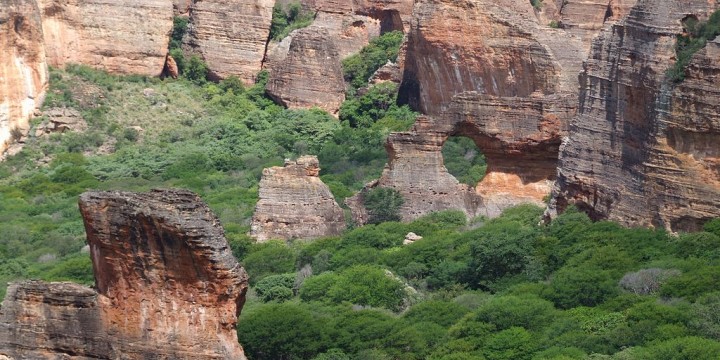Established in 1979, the Serra da Capivara National Park, covers nearly 129, 140 hectares and has a circumference of 214 kilometres in the south-eastern section of Piauí state in Brazil’s Northeast Region.
It is situated in the morphoclimatic zone of the Brazilian Caatinga, distinguished by the multiplicity of plant formations typical of the semi-arid regions of Northeast Brazil. The region’s plant species are primarily characterized by the loss of most of their leaves during the dry season, extending from May to December, serving to lend the landscape its silver hue. The region borders two major geological formations – the Maranhão-Piauí sediment basin and the peripheral depression of the São Francisco River – and is endowed with a diversity of relief vegetation and landscapes of breathtaking beauty and dotted with exceptional vistas of the surrounding valleys, mountains, and plains.
The area houses one of the most important archaeological sites in the Americas containing evidence and artefacts that have forced a sweeping re-evaluation of the fundamental traditional theories underpinning the origins of human settlement in the Americas.
Over 1300 archaeological sites have been found within the park, the majority consisting of rock and wall paintings dating from 50,000-30,000 years Before Present. Many of the numerous rock shelters in the Serra da Capivara National Park are decorated with rock paintings, some more than 25,000 years old. The analyses and dating of the evidence and artefacts found in the Serra da Capivara National Park serve to confirm the millennial presence of human beings on the American continent and the importance of the heritage. The ensemble of archaeological sites contains dating evidence that has thoroughly revolutionized classical theories regarding the entry route into the Americas by human populations along the Bering Strait. According to studies, the area encompassing the Serra da Capivara National Park was occupied by hunters and gatherers, followed by ceramic-farming societies. Discoveries at the Boqueirão da Pedra Furada archaeological site suggest that human beings may have settled the region as far back as 50,000 years ago, while the oldest remaining archaeological site with surviving rock art dates back 10,530 years Before Present. In the light of these new findings, the region represents one of the most significant archaeological sites in the world and the property is an outstanding testimony to one of the oldest human communities of South America
The Serra da Capivara National Park bears exceptional testimony to one of the oldest populations to inhabit South America. It constitutes and preserves the largest ensemble of archaeological sites, and the the oldest examples of rock art in the Americas. Moreover, the iconography of the paintings allows us to identify information about the region’s early peoples.
Formal establishment of the Park has served to ensure preservation of the archaeological sites, which stand as a testament to ancient human settlement in South America. Safely contained within the Park’s clear delimitations and 10-kilometer buffer zone, the area’s sites have remained effectively protected and intact, both in terms of their physical integrity preservation and historical and cultural value.













